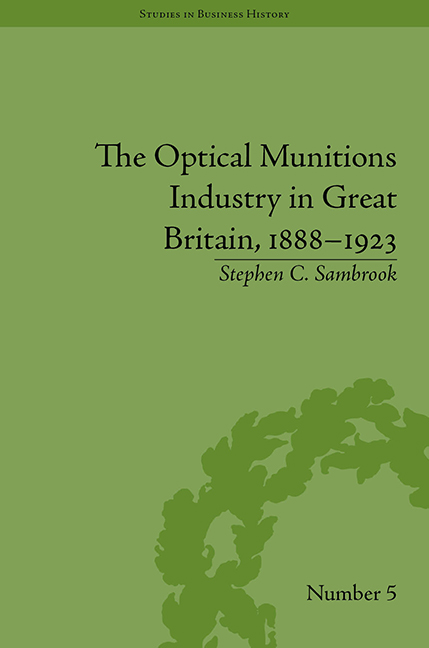Book contents
- Frontmatter
- CONTENTS
- Preface and Acknowledgements
- List of Figures and Tables
- List of Technical Terms
- Introduction
- 1 The Emergence of the Industry, 1888–99
- 2 The Growth in Importance from the Boer War to 1906
- 3 Expansion and Consolidation, 1907–14
- 4 The Impact of War, August 1914 to mid-1915
- 5 Industrial Mobilization: The Ministry of Munitions and its Relationship with the Industry
- 6 The Industry's Wartime, 1915–18
- 7 Industrial Demobilization and Implosion, 1919
- 8 Adaption and Survival, 1919–23
- Conclusion
- Notes
- Works Cited
- Index
7 - Industrial Demobilization and Implosion, 1919
- Frontmatter
- CONTENTS
- Preface and Acknowledgements
- List of Figures and Tables
- List of Technical Terms
- Introduction
- 1 The Emergence of the Industry, 1888–99
- 2 The Growth in Importance from the Boer War to 1906
- 3 Expansion and Consolidation, 1907–14
- 4 The Impact of War, August 1914 to mid-1915
- 5 Industrial Mobilization: The Ministry of Munitions and its Relationship with the Industry
- 6 The Industry's Wartime, 1915–18
- 7 Industrial Demobilization and Implosion, 1919
- 8 Adaption and Survival, 1919–23
- Conclusion
- Notes
- Works Cited
- Index
Summary
For the optical munitions industry, the signing of the armistice on 11 November 1918 came unexpectedly and, in one sense, prematurely. The effect of the cessation of fighting on Sunday, 11 November had almost immediate repercussions for its business in the form of order cancellations on what amounted to a heroic scale. This had in no way been anticipated by the industry. Irrespective of the political desire to end hostilities and the sentiments being voiced in the press, it had been very much ‘business as usual’ right up to 10 November 1918. There had been no scaling down of contracts and no warnings from the Ministry of Munitions of any imminent likelihood of cancellations. Indeed, firms were still being exhorted to step up production and new contracts were still being issued.
All the country's optical instrument manufacturers were wholly employed in the war effort and none had even begun to consider in practical terms any policies for industrial demobilization and a return to peacetime trading. Furthermore, the efforts of the Ministry's Optical Munitions and Glass Department (OMGD) to set the optical industry on a better footing had not yet reached a stage where substantial improvements in organization or infrastructure had been achieved. The pre-war optical instruments industry had been conscripted and undergone a metamorphosis into the wartime optical munitions industry with some considerable success, but nothing had been done to cater for the inevitable end of large-scale government orders.
- Type
- Chapter
- Information
- The Optical Munitions Industry in Great Britain, 1888–1923 , pp. 159 - 180Publisher: Pickering & ChattoFirst published in: 2014



